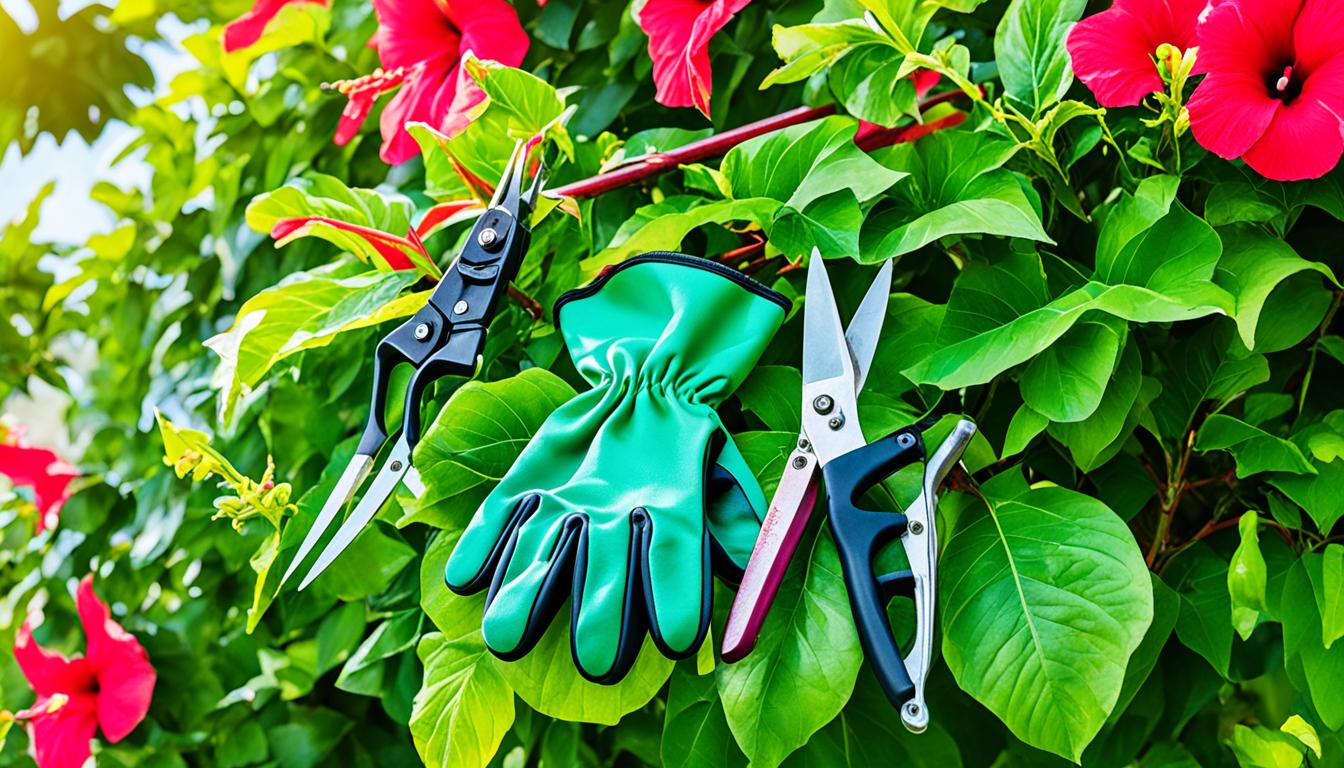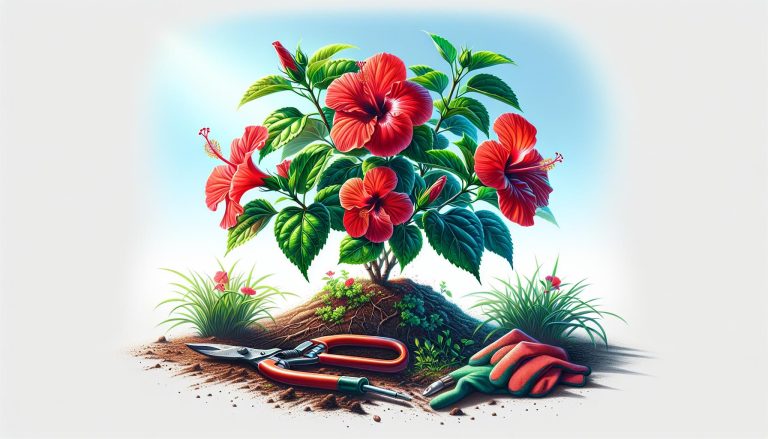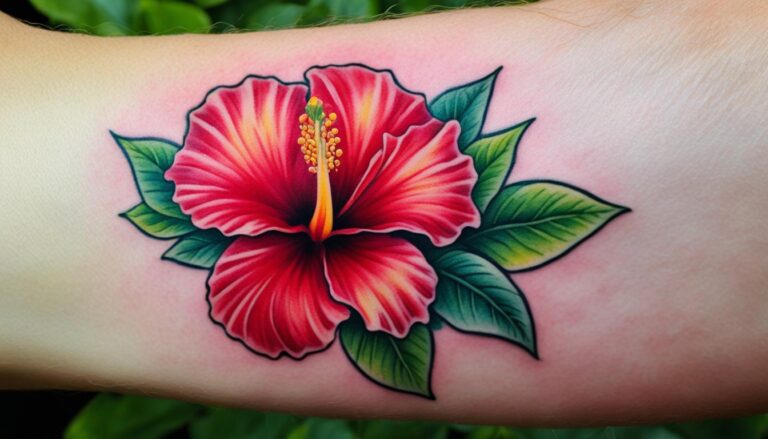Best Time to Trim Hibiscus in South Florida
Understanding when to trim hibiscus in South Florida is essential for maintaining vibrant and healthy plants. Pruning hibiscus at the right time not only ensures their optimal growth but also promotes an abundance of beautiful blooms. Let me share a story to set the stage.
Meet Sarah, a passionate gardener residing in sunny South Florida. Sarah had always admired the stunning hibiscus plants adorning her neighbor’s yard. Determined to have her own slice of tropical paradise, she decided to transform her front yard into a hibiscus haven.
Excitedly, Sarah planted different varieties of hibiscus, eagerly awaiting the moment they would burst into a riot of colors. However, as time passed, she noticed that her plants lacked the vigor and vibrancy she had envisioned.
Curious and determined, Sarah began researching hibiscus care in South Florida. She discovered that understanding the timing for trimming hibiscus was crucial for their overall health and blooming success.
Armed with her newfound knowledge, Sarah decided to prune her hibiscus during the late winter, just before the new growth cycle began. She carefully removed dead or damaged branches and shaped the plants to encourage new growth.
As spring approached, Sarah’s hibiscus plants began to thrive. Buds formed, and vibrant flowers bloomed, painting her yard with a multitude of colors. Sarah’s neighbors couldn’t help but stop and admire the beauty she had created.
From that day forward, Sarah made it a point to trim her hibiscus at the best time, ensuring consistent blooming and healthy growth.
Key Takeaways:
- Pruning hibiscus during late winter or early spring, just before the new growth cycle, promotes vibrant blooms.
- Light trimming can be done throughout the year to remove dead flowers and broken branches.
- Avoid heavy pruning in late fall or early winter to prevent damage from cooler temperatures.
- Timing is crucial for maintaining healthy and blooming hibiscus plants in South Florida.
- Understanding the needs of hibiscus, such as well-draining soil, ample sunlight, and regular watering, is important for their overall care.
Understanding Hibiscus and Their Needs
Hibiscus plants are a popular choice for South Florida gardens due to their ability to thrive in the warm, humid climate. In this region, the most common species of hibiscus are Hibiscus rosa-sinensis and Hibiscus coccineus.
The Needs of Hibiscus Plants
To ensure proper care and maintenance of hibiscus plants, it’s important to understand their basic needs:
- Well-draining soil: Hibiscus plants prefer soil that drains well to avoid waterlogging, as waterlogged soil can lead to root rot.
- Ample sunlight: Hibiscus plants thrive in full sunlight, so it’s essential to place them in a location where they can receive at least 6-8 hours of direct sunlight each day.
- Regular watering: These plants require regular watering, especially during dry periods. However, it’s important to avoid overwatering, as it can lead to root rot. Aim to keep the soil consistently moist, but not saturated.
Understanding these basic needs is crucial for providing the right environment for your hibiscus plants to flourish. In addition to these needs, knowing when to trim your hibiscus is an important aspect of their maintenance.
Hibiscus Care Tips: South Florida Hibiscus Trimming Schedule
Hibiscus plants benefit from regular pruning, which helps maintain their shape, remove dead or damaged branches, and stimulate new growth. In South Florida, the best time to trim hibiscus is during the late winter or early spring, just before the new growth cycle begins.
During this time, you can trim your hibiscus plants to remove any dead or damaged branches, and it also encourages the plants to produce new growth. However, it’s important to note that heavy pruning should be avoided in late fall or early winter to prevent damage from cooler temperatures.
Light trimming can be done throughout the year to remove dead flowers and broken branches, but major pruning should be reserved for the late winter or early spring. By following this South Florida hibiscus trimming schedule, you can promote healthier plants and ensure abundant blooms.
| Best Time to Trim Hibiscus in South Florida | Tasks |
|---|---|
| Late winter or early spring | Major pruning to remove dead or damaged branches and stimulate new growth |
| Throughout the year | Light trimming to remove dead flowers and broken branches |
| Late fall or early winter | Avoid heavy pruning to prevent damage from cooler temperatures |
By understanding the specific needs of hibiscus plants and following a proper trimming schedule, you can ensure the health and vitality of your hibiscus plants in South Florida.
The Importance of Timing: When to Trim Your Hibiscus in South Florida
Proper timing plays a crucial role in maintaining healthy and blooming hibiscus plants in South Florida. The optimal time to trim your hibiscus is during the late winter or early spring, just before the new growth cycle begins, taking advantage of the hibiscus pruning season in South Florida.
This timing is essential as it allows you to remove any dead or damaged branches that may have occurred during the winter months. By pruning during this period, you stimulate new growth, resulting in healthier plants and abundant blooms come spring. It’s the perfect opportunity to shape your hibiscus and remove any undesired growth, ensuring optimal flowering once the warmer season arrives.
While light pruning can be done throughout the year to remove dead flowers and broken branches, it’s important to avoid heavy pruning in late fall or early winter. Heavy pruning during this time can interfere with the hibiscus’s natural growth pattern and disrupt the blooming cycle.
To make the most of your hibiscus plants in South Florida, be mindful of the hibiscus pruning season and follow these south Florida gardening tips for hibiscus trimming:
- Trim hibiscus plants during the late winter or early spring, just before the new growth cycle begins.
- Avoid heavy pruning in late fall or early winter to prevent disruption of the blooming cycle.
- Perform light pruning throughout the year to remove dead flowers and broken branches.
By adhering to these timing guidelines, you’ll ensure that your hibiscus plants in South Florida thrive and reward you with their vibrant and beautiful blooms. Now that we understand the importance of trimming hibiscus, let’s explore the techniques and tools you’ll need for successful hibiscus pruning in South Florida.
| Benefits of Proper Timing | Timing Tips for Hibiscus Pruning |
|---|---|
| Remove dead or damaged branches | Trim during late winter or early spring |
| Stimulate new growth | Avoid heavy pruning in late fall or early winter |
| Ensure healthier plants | Perform light pruning throughout the year |
| Promote abundant blooms |
Proper timing is essential when it comes to trimming hibiscus plants in South Florida. By pruning during the late winter or early spring, you can remove dead or damaged branches, stimulate new growth, and ensure healthier plants with abundant blooms. Make sure to avoid heavy pruning in late fall or early winter and perform light pruning throughout the year. Following these south Florida gardening tips for hibiscus trimming will help your plants thrive and keep your garden vibrant.
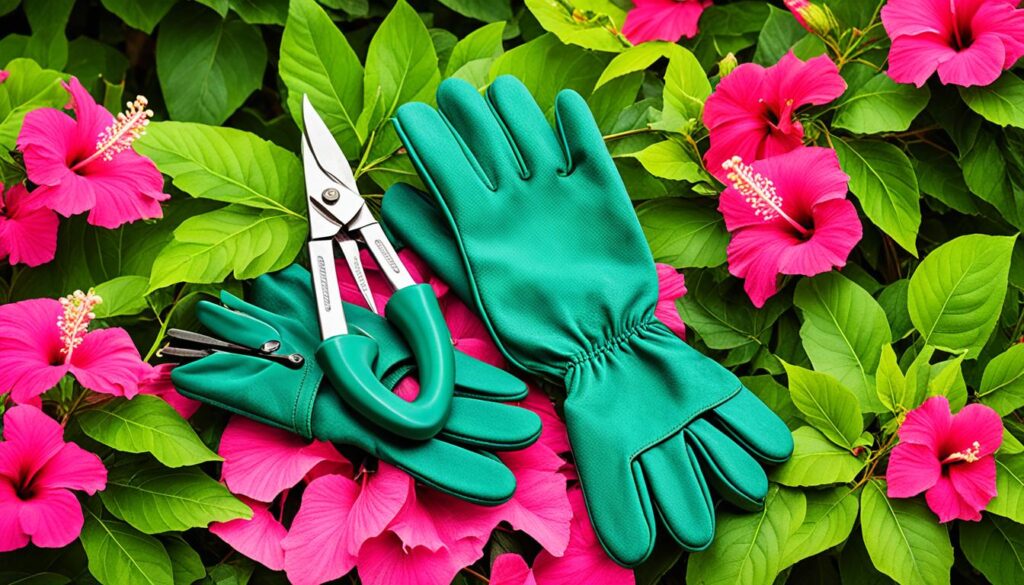
Spring Pruning: Setting the Stage for Blooming Success
Spring pruning is a crucial step in the care of hibiscus plants in South Florida. This season sets the stage for vibrant blooms and lush growth, ensuring your hibiscus thrives throughout the year. After the winter dormancy period, hibiscus plants are ready to burst into life, making it the ideal time to trim and shape them for optimal health and aesthetic appeal.
During spring pruning, it is essential to remove any frost-damaged branches from the winter months. These damaged branches can hinder the plant’s growth and overall appearance. Additionally, thinning out crowded areas allows for better air circulation and light penetration, resulting in healthier plants.
When trimming your hibiscus plants, it is important to use proper techniques and tools to ensure the best results. Make cuts just above nodes, where new leaves will emerge, to encourage fresh growth. This technique promotes branching and stimulates the production of beautiful blooms.
Remember to use clean pruning tools to prevent the spread of diseases. Disinfect your tools before and after each use to avoid introducing pathogens to your plants. This simple precaution can help keep your hibiscus healthy and thriving.
Key Tips for Spring Pruning:
- Remove frost-damaged branches.
- Thin out crowded areas for better air circulation and light penetration.
- Make cuts just above nodes to promote new leaf emergence.
- Use clean pruning tools to prevent disease spread.
Proper spring pruning sets the stage for blooming success in your hibiscus plants. By following these tips and techniques, you can ensure your hibiscus thrives with abundant, vibrant blooms. Don’t forget to continue regular maintenance and care throughout the year for the best results.
Summer Maintenance: Keeping Your Hibiscus Healthy and Vibrant
Summer maintenance plays a crucial role in ensuring the health and vibrancy of your hibiscus plants in South Florida. To keep your hibiscus thriving during the summer months, it is important to focus on proper watering, fertilizing, and regular inspection for pests and diseases.
Watering Tips: Adequate watering is essential for supporting the blooming cycle and maintaining healthy plants. Water your hibiscus in the early morning or late afternoon to minimize evaporation and ensure optimal absorption. Deep watering is preferable, allowing the water to penetrate the root zone. Avoid overwatering, as it can lead to root rot and other water-related issues.
Hibiscus Fertilizing Guide: Providing your hibiscus with the necessary nutrients is crucial for its overall growth and development. Use a balanced, slow-release fertilizer specifically designed for hibiscus plants. Follow the instructions on the package for dosage and application frequency. Applying the fertilizer at the beginning of the summer and once every six to eight weeks thereafter will help maintain the plant’s vigor and encourage blooming.
Regular Inspection: Regularly inspecting your hibiscus plants for pests and diseases is vital in preventing and addressing issues before they escalate. Look for common pests such as aphids, spider mites, and whiteflies. If you notice any signs of damage or infestation, take immediate action by using organic or chemical sprays targeted specifically for hibiscus plants. This proactive approach will help keep your hibiscus healthy and thriving throughout the summer.
Pruning: Light pruning can be done during the summer to remove dead or damaged branches and old blooms. This not only improves the appearance of the plant but also encourages new growth and blooming. Use clean and sharp pruning tools to minimize the risk of introducing infections.
By implementing these summer maintenance practices, you can ensure that your hibiscus plants in South Florida remain healthy, vibrant, and ready to showcase their beautiful blooms.
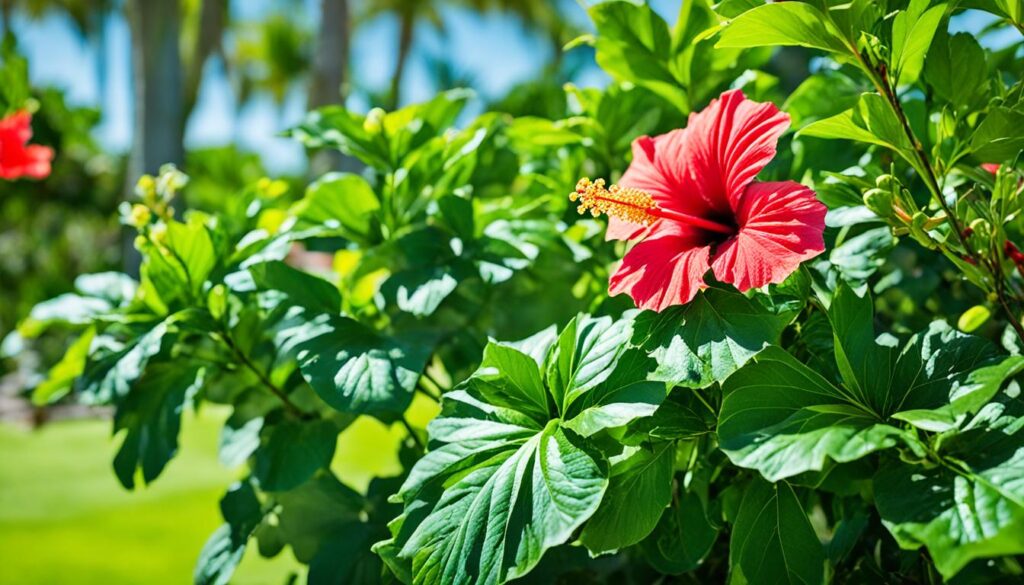
Fall and Winter Care: Preparing Your Hibiscus for Cooler Months
As the temperatures cool down in South Florida, it’s important to adjust your hibiscus care routine to ensure the plants remain healthy during the fall and winter months. Proper preparation and protection are key to maintaining the vigor of your hibiscus plants and ensuring they continue to thrive come spring. Here are some essential tips for caring for your hibiscus in fall and winter:
1. Gradually Reduce Watering
With the arrival of fall, it’s time to gradually reduce the frequency and amount of watering for your hibiscus plants. While it’s important not to let the soil become completely dry, overwatering should be avoided as well. Strike a balance by monitoring the moisture level of the soil and adjusting your watering schedule accordingly. This gentle reduction in watering will help prepare the plants for cooler temperatures without causing dehydration.
2. Minimize Pruning
In fall and winter, minimize the amount of pruning you do to your hibiscus plants. Instead of heavy pruning, focus on removing any dead or diseased parts of the plant. This will help maintain the overall health and aesthetics of the hibiscus. Heavy pruning during this season can inhibit the plant’s ability to recover and grow as it prepares for the colder months.
3. Protect from Potential Frost
In South Florida, occasional cold snaps can pose a risk to hibiscus plants. To protect your hibiscus from potential frost damage, consider covering them with a breathable fabric or a frost cloth on colder nights. This extra layer of protection can help shield the plants from the freezing temperatures and prevent damage to the sensitive foliage.
4. Apply Balanced Slow-Release Fertilizer
Before the onset of winter, give your hibiscus plants a boost by applying a balanced slow-release fertilizer. This will provide the necessary nutrients to sustain the plants during the dormant period. Choose a fertilizer specifically formulated for hibiscus and follow the manufacturer’s instructions for application rates. This step will ensure your hibiscus remains nourished and ready to thrive when spring arrives.
By following these fall and winter care tips, you’ll be providing your hibiscus plants with the ideal environment for the cooler months. The gradual reduction in watering, minimal pruning, frost protection, and nutrient application will support the plants’ health and help them survive winter dormancy. With proper care, your hibiscus will be ready to burst into vibrant blooms when spring arrives.
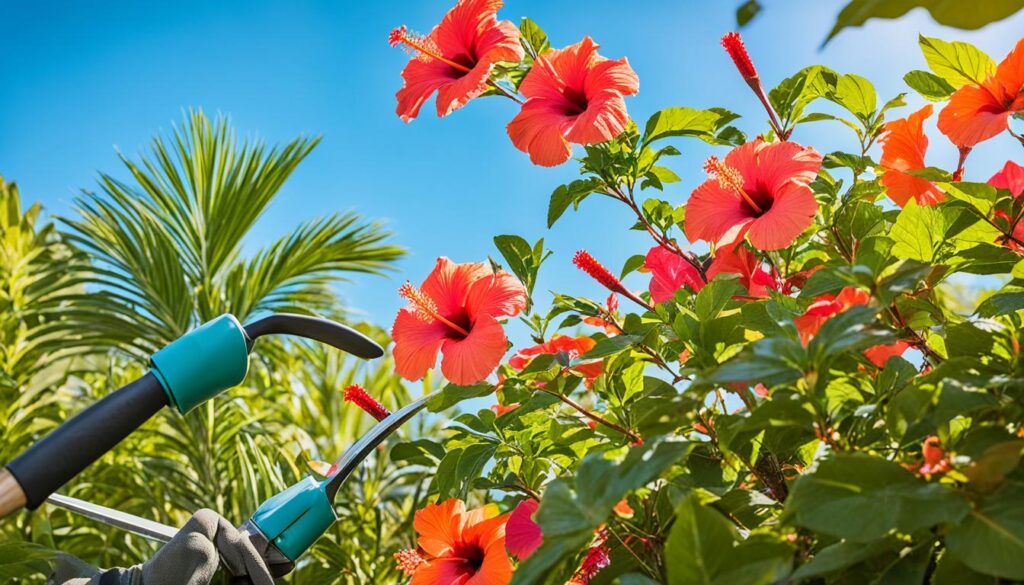
Expert Tips for Trimming Hibiscus: Techniques and Tools
Trimming hibiscus plants in South Florida requires a good understanding of the right techniques and tools. The goal is to promote healthy growth and vibrant blooms throughout the year. Here are some expert tips to help you trim your hibiscus effectively:
1. Timing is Key
The best time to trim your hibiscus in South Florida is during the late winter, just before the new growth season begins. This timing allows for the removal of dead or damaged branches and encourages new growth. Avoid heavy pruning in the fall or early winter to prevent disruption of the blooming cycle.
2. Light Maintenance Pruning
While major pruning should be done in the late winter, light maintenance pruning can be done throughout the year. This includes the removal of dead flowers and broken branches. Regularly inspect your plants and trim as needed to maintain their shape and health.
3. Proper Techniques
When trimming hibiscus, make your cuts just above the nodes (the areas where new leaves emerge) to encourage healthy growth. This technique helps the plants develop a bushier and more compact form. Additionally, use sharp and clean pruning tools to ensure clean cuts and minimize the risk of disease transmission.
4. Choosing the Right Pruning Tools
Investing in the right pruning tools will make the trimming process easier and more efficient. Look for quality pruning shears or hand pruners with sharp blades that can make clean cuts. Long-handled loppers are ideal for reaching higher branches, while pruning saws are useful for thicker branches. Remember to keep your tools clean and well-maintained to ensure their effectiveness.
By following these expert tips and using the right techniques and tools, you can successfully trim your hibiscus plants in South Florida. These practices will promote their growth, enhance their appearance, and ensure abundant blooms season after season.
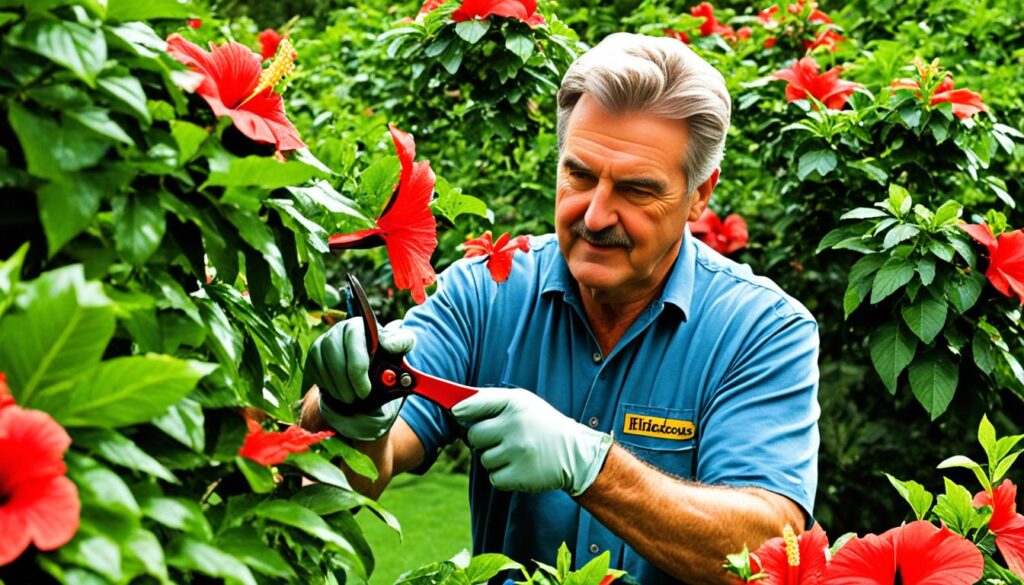
Conclusion
Proper timing is crucial for trimming hibiscus plants in South Florida. Late winter or early spring is the best time for major pruning, as it removes dead or damaged branches and stimulates new growth. This promotes healthier plants and vibrant blooms. Light maintenance pruning can be done year-round to remove dead flowers and broken branches.
In addition to timing, several key takeaways for hibiscus pruning in South Florida are essential for their overall care. Adequate watering, fertilizing, and pest management play crucial roles in maintaining the health and vitality of hibiscus plants. Regular inspection and prompt treatment for pests and diseases are essential.
Furthermore, protecting the plants during colder months is important to safeguard them from potential frost damage. By implementing these practices, you can ensure that your hibiscus plants in South Florida remain healthy, vibrant, and blooming throughout the year.

